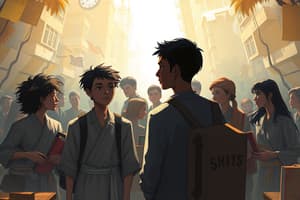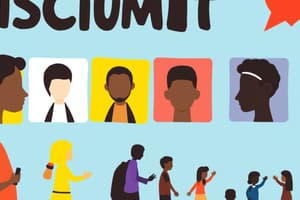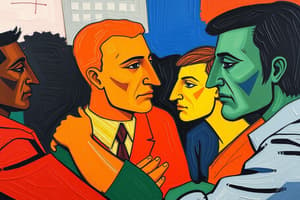Podcast
Questions and Answers
What did you learn from this film?
What did you learn from this film?
No matter what age you are, it is easy to be taught to discriminate against others.
What scene or scenes do you think you'll still remember a month from now and why?
What scene or scenes do you think you'll still remember a month from now and why?
At break one kid called another brown eyes; the people that were told they were stupid actually ended up performing worse.
Did any part of the film surprise you? Do you think someone of a different race, ethnicity, or religion would also find it surprising? Why?
Did any part of the film surprise you? Do you think someone of a different race, ethnicity, or religion would also find it surprising? Why?
The fact that people can be manipulated so easily to a point where something like eye color can be turned into something used to treat people differently.
What did the children's body language indicate about the impact of discrimination?
What did the children's body language indicate about the impact of discrimination?
How did the negative and positive labels placed on a group become self-fulfilling prophecies?
How did the negative and positive labels placed on a group become self-fulfilling prophecies?
In the prison seminar, what do you think about the assertion that all people face some kind of discrimination?
In the prison seminar, what do you think about the assertion that all people face some kind of discrimination?
What do you think about whether this discrimination exercise should be done with all children? Motivate your answer.
What do you think about whether this discrimination exercise should be done with all children? Motivate your answer.
What features did Elliott ascribe to the superior and inferior groups and how did those characteristics reflect stereotypes about blacks and whites?
What features did Elliott ascribe to the superior and inferior groups and how did those characteristics reflect stereotypes about blacks and whites?
How did Elliott's discrimination create no-win situations for those placed in the inferior group?
How did Elliott's discrimination create no-win situations for those placed in the inferior group?
What does the answer of the boy who was teased suggest about the use of violence as a political strategy?
What does the answer of the boy who was teased suggest about the use of violence as a political strategy?
How is the blue eyes/brown eyes exercise related to the Sioux prayer, 'Help me not judge a person until I have walked in his shoes'?
How is the blue eyes/brown eyes exercise related to the Sioux prayer, 'Help me not judge a person until I have walked in his shoes'?
Flashcards are hidden until you start studying
Study Notes
Discrimination and Its Impact
- Discrimination can be learned at any age, demonstrating the ease of fostering prejudice within individuals.
- A significant scene involved name-calling, illustrating how labels like “brown eyes” led to poor performance among labeled individuals, emphasizing the psychological impact of discrimination.
Manipulation and Perception
- The manipulation of individuals based on superficial differences (like eye color) reveals how easily perceptions can be altered, fostering unequal treatment without basis.
Body Language Signals
- Children displayed hunched body language, showing their feelings of hopelessness and anxiety about being treated unequally in school settings.
Self-Fulfilling Prophecies
- Labels assigned to groups foster self-fulfilling prophecies; claims of inferiority led to decreased performance, while claims of superiority instigated arrogance.
Understanding of Discrimination
- Discussion on discrimination reveals perspectives that while white individuals may not face daily discrimination, they can still experience prejudice for intersecting identities, such as being Jewish.
Early Education on Discrimination
- Teaching children about discrimination early on is essential; understanding these concepts empowers future generations to identify and oppose prejudice.
Stereotypes in the Exercise
- Elliott associated traits such as ignorance and bad listening with blue-eyed individuals, reflecting harmful stereotypes often directed at marginalized groups, while brown-eyed individuals were labeled as superior.
No-Win Situations
- Elliott's methods resulted in no-win situations for the inferior group as all actions were scrutinized to support discriminatory stereotypes.
Violence as a Response
- The conflicted feelings of children regarding violence indicated that aggression does not resolve underlying issues or bullying, calling into question the effectiveness of violence as a response to political or social strife.
Empathy and Understanding
- The blue eyes/brown eyes exercise highlights the need for empathy, similar to the Sioux prayer urging individuals to refrain from judgment until they experience another's circumstances.
Studying That Suits You
Use AI to generate personalized quizzes and flashcards to suit your learning preferences.




